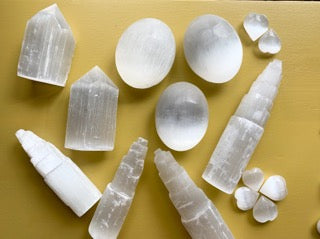
Satin Spar vs Selenite vs Gypsum: What's What?
Share
In the mineral and crystal collection world, the terms satin spar and selenite are often used interchangeably, despite them having distinctly different looks. Here, we will go over the similarities and differences of these materials.
Gypsum
Gypsum is a mineral that is commonly found in sedimentary rocks. It’s a soft sulfate mineral composed of calcium sulfate dihydrate, with the chemical formula CaSO4·2H2O. Gypsum is a common mineral and can be found worldwide in a variety of forms, including massive beds, layers, and grains.
Gypsum is widely used in a number of industries, including construction, agriculture, and medicine. In the construction industry, gypsum is used to manufacture plaster, drywall, and cement. In agriculture, gypsum is used as a soil amendment to improve soil structure and fertility. In medicine, gypsum is used to make casts for broken bones, as well as dental and orthopedic impressions.
Gypsum is also known for its unique properties, such as its ability to be molded and hardened when mixed with water. It is non-toxic and non-flammable, making it a safe and versatile material for a wide range of applications.
Satin spar, selenite, desert roses, and (some) alabaster are all forms/types of gypsum, but do have some differences in terms of appearances and properties.
Satin Spar
Satin spar is a fibrous variety of gypsum that has a pearly luster and a silky texture. It often forms in compact masses or in parallel fibrous veins. Satin spar is commonly used as a decorative stone, as it can be polished to a high sheen and is translucent, allowing light to pass through it. 
It can be found in a variety of locations around the world where gypsum is present. Some of the major producers of satin spar include the United States, Mexico, Spain, Italy, and Brazil. In the United States, large deposits of gypsum are found in states such as Oklahoma, Texas, and Utah.
Satin spar can also be found in smaller deposits in other regions around the world, including Africa, Australia, and Asia.

It has a Mohs hardness of 2, making it easy to carve and work with. Many shapes and figurines can be carved from satin spar, in addition to display bowls and dishes. In our shop, satin spar is most popular in display dishes and large spheres that can be lit up from the bottom using LED light bases, and as small sticks that can be kept with other tumbles.
Selenite
Selenite, on the other hand, is a transparent or translucent form of gypsum that typically occurs as massive, twinned crystals. It is often colorless or white, and can have a vitreous or pearly luster. The original name was given by J.G. Wallerius in his 1747 book "Mineralogia, eller Mineralriket."

Selenite is commonly used in crystal healing and meditation practices, as it is believed to have a calming and cleansing effect on the body and mind.
Selenite is found in many locations around the world, including the United States, Mexico, Brazil, Russia, Greece, Poland, France, and Australia. In the United States, selenite is found in many states, including California, Oklahoma, Texas, Utah, and New Mexico. In these areas, selenite can be found as large, clear crystals, as well as in massive form and as part of sedimentary deposits.
One of the most famous locations for selenite is the Cave of the Crystals in Naica, Mexico. This underground cave contains massive selenite crystals that can reach up to 39 feet (12 meters) in length and weigh up to 55 tons. The extreme conditions within the cave make it difficult for humans to enter, but it has been studied by scientists for its unique geological features.
We typically sell selenite as natural looking trays for displaying and/or charging other crystals. We have trays as small as a few inches wide up to two feet wide. It’s hard not to find selenite intriguing and beautiful!
Desert Rose
Desert rose is a crystal formation that is commonly found in arid regions around the world, such as deserts and dry lake beds. It is a type of evaporite mineral, which means it is formed from the evaporation of water containing dissolved minerals.
Gypsum desert rose is a type of desert rose formation that is made of the mineral gypsum. It is commonly found in arid regions around the world, such as deserts and dry lake beds. Gypsum desert roses are formed through a process of slow evaporation of water containing dissolved minerals, similar to other types of desert roses. The distinctive rose shape of gypsum desert roses is created by the growth of crystal clusters in a circular pattern, with individual crystals radiating outwards from a central point. The crystals are typically translucent and can range in color from white to beige, pink, or brown and can range in size from small, hand-sized pieces to large, multi-layered formations that can be several feet in diameter.

Desert roses can be found in regions where the conditions are right for their formation, including the southwestern United States, Mexico, and North Africa.
Desert roses are often used as decorative displays. They are also popular among mineral collectors and are valued for their unique shape and coloration. Our shop typically has these mineral formations available in a variety of sizes from smaller than an inch across to over a foot across.
Alabaster
There are two main types of alabaster: gypsum alabaster and calcite alabaster. Gypsum alabaster is the most common type and is usually white or light-colored with a fine grain. Calcite alabaster, on the other hand, is less common and is usually banded or veined with various colors.
Alabaster has been used for thousands of years for carving sculptures, vessels, and decorative objects. It is a soft material that can be easily carved and polished, making it ideal for intricate designs and delicate details. Alabaster is also prized for its translucency, which allows it to be backlit to create a glowing effect.
Gypsum Care
In general, it is not recommended to expose this mineral group to water for an extended period of time. Water can cause the fibers to break down and cause the material to deteriorate or dissolve.
If satin spar comes into contact with water, it’s best to dry it thoroughly as soon as possible to prevent any damage. If the water has caused any discoloration or staining, it may be possible to remove it by gently cleaning the surface with a soft cloth dampened with a mild detergent and water. However, it is important to be very gentle to avoid damaging the surface of the satin spar or selenite, as both can easily splinter.
That being said, we have done experiments where we have soaked pieces of satin spar in dishes of water for periods up to several months, with no change in overall weight of the piece compared to pre-soak. Getting your pieces wet is not a huge concern, and they can be gently scrubbed or even soaked in water to remove caked on dirt if necessary. If using any polishing or lapidary techniques on satin spar or selenite, always work with the stone wet to reduce dust creation which can be hazardous to your health.

Why do we love satin spar, selenite, desert rose (gypsum)?
The neutral and generally muted colors tend to go well with other materials, and you just can’t beat the way satin spar and selenite catch the light! Some of our favorites are lighting up satin spar bowls and towers over light bases, or using selenite as a tray to display other minerals. The variety of forms this material takes also creates the desire to collect each different type to create a truly stunning and visually interesting display.

Do you love satin spar and selenite as much as we do? Check out the collection we made just for all of us gypsum lovers!

